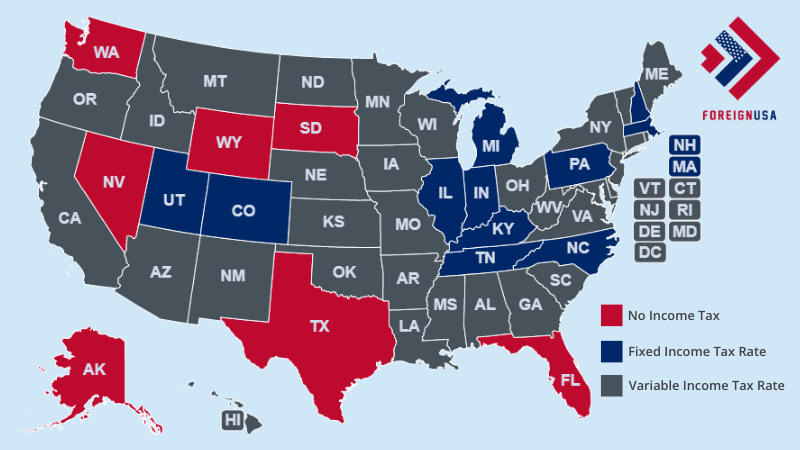Taxes are a certainty that we all must pay, and I have compiled a comprehensive list of the US income tax rates for every state in 2023.
One of the key questions people ask me all the time when I am writing their business plan is, “how much tax do I have to pay on my earnings.” In the U.S., there is no simple answer. US income tax rates vary by state, and each state has its own personal income tax rate, while some have none.
It is important to know the income tax rate based on where you live, the state you are considering moving to, or the state, as a foreigner, you are looking to become the next place you call home.
The state income tax rate can and will play a role in how much tax you will pay on your income.
The following map shows a list of states by income tax rate for 2023. The map is interactive, and you can hover over any US state to see the rate or range of income tax that each of the states imposes.
US Income Tax Rates by State
I have summarized the US income tax rates by state for 2023, showing you what the respective rate is in each of the 50 US states. In addition, you can discover more details on the specific income tax you are required to pay in the state you live in. See the table at the bottom of this page.
The US income tax rates by state for 2023 vary depending on where you live.
Here is a list of nine states in the US that have no income tax:
- Alaska
- Florida
- Nevada
- New Hampshire
- South Dakota
- Tennessee
- Texas
- Washington
- Wyoming
In addition to the above, New Hampshire taxes interest and dividends at a rate of 5%. To see more information on states with no income tax, visit the article I created.
US State Income Tax Rates for 2023
The general approach to US state income tax rates is done in three different ways.
- Residents and those working in a specific state either do not pay any income tax at all;
- They pay a flat rate of income tax, including on interest and dividends, and this income tax rate does not change based on the level of earnings;
- Or, the state you live in imposes a progressive tax. This means that people with higher taxable incomes pay higher state income tax rates, and those with lower incomes pay less tax.
Most people live and work in the same state for the entire year. This is your state of residence and determines the rate of income tax you pay.
You may have a job that requires travel to other states, but this does not typically affect the rate of tax you pay on your income; it is the state you live in that determines this.
However, if you lived in one state for part of the year and moved to another state, you may owe state income tax to two different states at two different rates. Similarly, if you work in one state and own income-generating property in another, you may be liable to pay income tax in more than one state, which may require more than one tax return.
What is a State Income Tax?
US state income tax rates on a per-state basis are collected to primarily fund state budgets rather than the federal government. It is a similar tax to federal income tax but different in the sense that it is designed to benefit the state you earned your income in (where you live), rather than fund the federal government as a whole.
While it is an attractive proposition for you and your family to move to a state with no income, such as the nine states mentioned above, the question then becomes whether you have to make up the difference in other types of taxes and ultimately pay more than those who live in states that impose a state income tax.
The most common way for states with no income tax to generate tax revenue that subsidizes the lack of income tax they are charging you is through sales tax.
Most of the nine states that charge no income tax have plenty of people spending money within the state, and sales tax rates (mostly on products, but some services too) are in the 4-11% range, with many specific areas of each state imposing a supplemental tax to fund infrastructure and transportation, etc.
States With Flat Rate Income Tax
There are eleven states in the U.S. that try to keep things simple when it comes to state income tax rates.
If you earn $50,000 per year or $500,000 per year, the person earning $50,000 will pay the same percentage of income tax as the person who earns $500,000.
States that impose a flat rate of income tax:
- Arizona – 2.5%
- Colorado – 4.4%
- Idaho – 5.8%
- Illinois – 4.95%
- Indiana – 3.15%
- Kentucky – 4.5%
- Massachusetts – 5.0%
- Michigan – 4.25%
- New Hampshire – 5% (only on dividends and interest income)
- North Carolina – 4.75%
- Pennsylvania – 3.07%
- Utah – 4.85%
So, to summarize, 41 states levy individual state income taxes on your wages/salaried income. Nine states levy no income tax, and New Hampshire, which charges no income tax on your paycheck, does charge tax on interest and dividends, although this is being phased out.
The following table shows a list of states by the income tax rate (including D.C.). It shows the income tax range in percentage terms for those states that levy a higher tax rate based on your level of income, including the progressive tax brackets.
For those that charge a flat rate regardless of your income, you will see that flat rate in the table, and it is also noted that there is only one fixed income tax levied.
| State | 2023 Tax Rates | # of Income Tax Brackets | Lowest to Highest Income Brackets |
|---|---|---|---|
| Alabama | 2.0% -5.0% | 3 | $500 - $3,001 |
| Alaska | 0% | No Income Tax | All Income Levels |
| Arizona | 2.5% | Flat Income Tax Rate | All Income Levels |
| Arkansas | 0% - 4.7% | 5 | $5,100 - $87,000 |
| California | 1% - 12.3% | 9 | $10,099 - $677,276 |
| Colorado | 4.4% | Flat Income Tax Rate | All Income Levels |
| Connecticut | 3% - 6.99% | 7 | $10,000 - $500,000 |
| Delaware | 0% - 6.6% | 7 | $2,000 - $60,001 |
| District of Columbia | 4% - 10.75% | 6 | $10,000 - $1,000,000 |
| Florida | 0% | No Income Tax | All Income Levels |
| Georgia | 1% - 5.75% | 6 | $750 - $7,001 |
| Hawaii | 1.4% - 11% | 12 | $2,400 - $200,000 |
| Idaho | 5.8% | Flat Income Tax Rate | All Income Levels |
| Illinois | 4.95% | Flat Income Tax Rate | All Income Levels |
| Indiana | 3.15% | Flat Income Tax Rate | All Income Levels |
| Iowa | 4.4% - 6% | 4 | $6,000 - $75,000 |
| Kansas | 3.1% - 5.7% | 3 | $15,000 - $30,000 |
| Kentucky | 4.5% | Flat Income Tax Rate | All Income Levels |
| Louisiana | 1.85% - 4.25% | 3 | $12,500 - $50,001 |
| Maine | 5.8% - 7.15% | 3 | $24,500 - $58,050 |
| Maryland | 2% - 5.75% | 8 | $1,000 - $250,000 |
| Massachusetts | 5% - 9% | 2 | $8,000 - $1,000,000 |
| Michigan | 4.05% | Flat Income Tax Rate | All Income Levels |
| Minnesota | 5.35% - 9.85% | 4 | $28,080 - $183,341 |
| Mississippi | 0% - 5% | 2 | $10,001 & over is subject to a 5% flat rate |
| Missouri | 1.5% - 4.95% | 8 | $1,207 - $8,449 |
| Montana | 1% - 6.75% | 7 | $3,600 - $21,600 |
| Nebraska | 2.46% - 6.64% | 4 | $3,700 - $35,730 |
| Nevada | 0% | No Income Tax | All Income Levels |
| New Hampshire | 4% | No Income Tax | No Income Tax (4% on interest/dividends) |
| New Jersey | 1.4% - 10.75% | 7 | $20,000 - $1,000,000 |
| New Mexico | 1.7% - 5.9% | 5 | $5,500 - $210,000 |
| New York | 4% - 10.9% | 9 | $8,500 - $25,000,000 |
| North Carolina | 4.75% | Flat Income Tax Rate | All Income Levels |
| North Dakota | 0% - 2.95% | 3 | $44,775 - $225,975 |
| Ohio | 0% - 3.99% | 5 | $26,050 - $115,300 |
| Oklahoma | 0.25% - 4.75% | 6 | $1,000 - $7,200 |
| Oregon | 4.75% - 9.9% | 4 | $3,750 - $125,000 |
| Pennsylvania | 3.07% | Flat Income Tax Rate | All Income Levels |
| Rhode Island | 3.75% - 5.99% | 3 | $73,450 - $166,950 |
| South Carolina | 0% - 6.4% | 3 | $3,200 - $16,040 |
| South Dakota | 0% | No Income Tax | All Income Levels |
| Tennessee | 0% | No Income Tax | All Income Levels |
| Texas | 0% | No Income Tax | All Income Levels |
| Utah | 4.65% | Flat Income Tax Rate | All Income Levels |
| Vermont | 3.35% - 8.75% | 4 | $45,400 - $229,500 |
| Virginia | 2% - 5.75% | 4 | $3,000 - $17,001 |
| Washington | 0% | No Income Tax | 7% long-term capital gains tax on profits of $250,000 or more |
| West Virginia | 2.36% - 5.12% | 5 | $10,000 - $60,000 |
| Wisconsin | 3.54% - 7.65% | 4 | $13,810 - $304,170 |
| Wyoming | 0% | No Income Tax | All Income Levels |
All States Income Tax Rate Map



